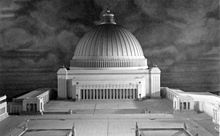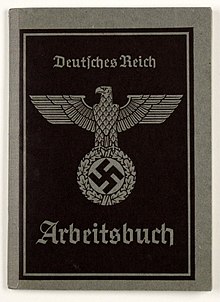User:Roscoetherooster/Nazi architecture
Article Draft
[edit]Lead
[edit]Formal elements like flat roofs, horizontal extension, uniformity, and the lack of decor created "an impression of simplicity, uniformity, monumentality, solidity and eternity," which is how the Nazi Party wanted to appear. Greek and Roman influence could also be seen in Nazi architecture and typography, as they drew inspiration from monumental architecture of ancient Rome and Greece to create a sense of power. The Nazis also shut down the Bauhaus movement, which emphasized functionalism and simplicity.
The Nazi regime also staged several "Degenerate Art" exhibitions to condemn modern art as harmful to German culture. This led to the persecution of many artists and architects, including members of the Bauhaus movement.
The Volkswagen was also a product of Nazi architecture and industrial design. Hitler commissioned Ferdinand Porsche[1] to design a "people's car" that was supposed to be affordable and accessible to all Germans, which resulted in the creation of the Volkswagen Beetle.
Article body
[edit]Greek and Roman influence
[edit]
Hitler was fascinated by the Roman empire and its architecture, which he imitated with a stripped-down style called "starved neo-Classicism." In 1934, he put Albert Speer in charge of building construction and began an ambitious program to create massive public buildings, including a Führermuseum in Linz, Austria. Hitler had a long-standing vision for a monumental Volkshalle or Grosse Halle, and Speer created a design for a building that would dwarf any structure in existence at the time, with a seating capacity of 180,000 and a dome 16 times larger than that of St. Peter's Basilica in Rome. The building was meant to inspire awe and emphasize the power of the Nazi state, rather than any spiritual or religious sentiment unlike Roman or Greek buildings.[2]
Typography
[edit]
The Nazis wanted to bring all aspects of society together under a process called Gleichschaltung. It began immediately after the Nazis came into power. They used propaganda, censorship, and mass rallies to enforce their message. The new typography was inspired by Classical Roman Imperial letterforms, which was Hitler's own preference.[3]
Degenerate Art
[edit]Exhibitions
[edit]The Nazis associated modern art with democracy and pacifism and labeled it "degenerate" due to supposed Jewish and Communist influences. They sought to control art and favored more realistic and classical styles over avant-garde art. This was the result of disagreements among leaders, including Alfred Rosenberg and Joseph Goebbels, with Goebbels ultimately conforming to Hitler's preference.[4]

In July 1937, the Nazi party held two art exhibitions in Munich. The Great German Art Exhibition displayed works that Hitler approved of, while the Degenerate Art Exhibition showcased modern, abstract, and non-representational art that the Nazis deemed "degenerate." The aim of the exhibition was to encourage a negative reaction and portray it as a symptom of an evil plot against the German people. The exhibition attracted over a million visitors, and some of the art was later burned by the Nazis. However, being banned by the Nazis gave some of the artists a positive image, and they are now considered among the greats of modern art.[5]
Disposal of Degenerate Art
[edit]In 1937, the Nazis took over 20,000 modern artworks. The next year, they made selling confiscated artworks legal and sold the artworks at a large auction in Switzerland, and In 1939, the Nazis burned 5,000 paintings they couldn't sell. [6]
The Bauhaus movement began in 1919, in Weimar, Germany. It was a school that brought together artists and craftspeople to pursue and master their crafts together in one place. The movement's aim was to create a utopian society for artists and designers. The first version of the school was under the leadership of Walter Gropious for nine years. The school then moved to Dessau in 1925, where Gropious designed the Bauhaus Building and several other buildings. The school moved to Berlin in 1932, but under constant harassment by the Nazis, it finally closed.[7]
Cars
[edit]Volkswagen
[edit]Hitler took inspiration from the United States for its mass motorization and mass consumption and used it as a model for his plans. German technicians were impressed by American manufacturing technology and imitated Ford's one-model policy. The Volkswagen was supposed to bring millions of new buyers, but most people couldn't afford one because of their recession. [8]

The Volkswagen failed during the Nazi regime because the Nazis failed to create a viable economic basis for the volkswagen, as the subsidies on the cars werent helping because operating expenses were the number one cost of the Volkswagen; The Nazi autarky policy led to a substantial increase in gas, oil, and tire costs. Furthermore, Nazi policy prioritized preparing for war through autarky rather than supplying goods for the people, resulting in difficulties for the Volkswagen project. Despite these challenges, Nazi leaders and Volkswagen managers envisioned the car's success after a victorious war, with plans to manufacture only the Volkswagen and no other cars. [8]
References
[edit]- ^ "Volkswagen is founded". History.com. Retrieved 2023-04-16.
- ^ "Nazi Architecture: Hitler's Grandiose Plans for Imperial Berlin - Articles by MagellanTV". www.magellantv.com. Retrieved 2023-04-03.
- ^ Verfasser, Aynsley, Jeremy 1955-. Graphic design in Germany 1890 - 1945. ISBN 0-500-51007-5. OCLC 723452550.
{{cite book}}:|last=has generic name (help)CS1 maint: multiple names: authors list (link) CS1 maint: numeric names: authors list (link) - ^ ""Degenerate" Art". encyclopedia.ushmm.org. Retrieved 2023-04-11.
- ^ "Degenerate art: Why Hitler hated modernism". BBC News. 2013-11-06. Retrieved 2023-04-03.
- ^ ""Degenerate" Art". encyclopedia.ushmm.org. Retrieved 2023-04-16.
- ^ "Bauhaus". History.com. Retrieved 2023-04-16.
- ^ a b König, Wolfgang (2004). "Adolf Hitler vs. Henry Ford: The Volkswagen, the Role of America as a Model, and the Failure of a Nazi Consumer Society". German Studies Review. 27 (2): 249–268. doi:10.2307/1433081. ISSN 0149-7952.
